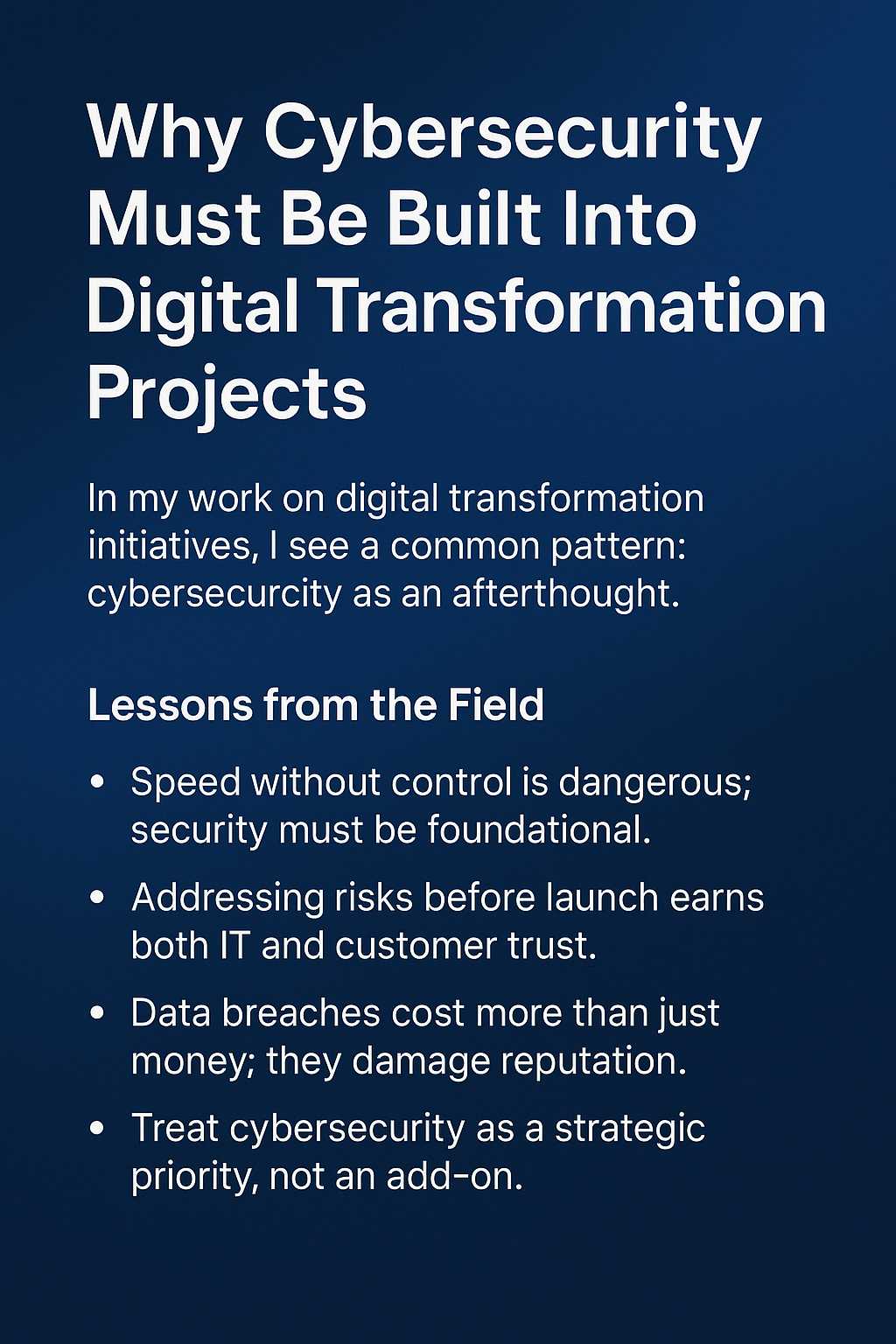When I reflect on the digital transformation projects I’ve led or advised on, there’s one recurring blind spot I continue to encounter — cybersecurity as an afterthought.
It’s not always intentional. Often, teams are focused on launching a new platform, automating operations, or integrating data across silos. Cybersecurity feels like something to “add later” — once the foundation is in place.
But here’s what experience has taught me:
If security isn’t built into your transformation roadmap from day one, you’re not transforming — you’re just exposing.
Let me explain.
The Speed vs. Security Dilemma
Digital transformation is often synonymous with speed. You want to go to market faster, scale services faster, migrate to the cloud faster.
But speed without control is dangerous.
I’ve seen organizations move critical workloads to the cloud, only to realize too late that their identity and access controls were lax — or worse, misconfigured.
Security isn’t a layer you sprinkle on top of a system once it’s built. It’s a core architectural principle, just like scalability, usability, or performance.
When you move fast without securing:
- You open the door to breaches, data leaks, and compliance violations.
- You damage customer trust, which is far harder to rebuild than any application.
- You create technical debt that’s expensive, time-consuming, and risky to fix.
Lessons from the Field
In one project I worked on, we were helping a legacy financial system modernize to a cloud-native stack. The goal was to migrate services, APIs, and data into a unified platform that could serve both internal operations and customer-facing apps.
The initial roadmap didn’t include a formal security track. It had performance SLAs, deployment sprints, and business enablement goals — but no security requirements.
We hit pause.
Why? Because pushing sensitive financial data through APIs without encryption policies, threat modeling, or proper access governance was a risk not worth taking.
We brought in security architects, ran a risk assessment, and integrated IAM, data encryption, API throttling, and logging mechanisms — all before launch. The result?
A system that not only performed but earned trust across the board — IT, compliance, and the end customers.
The Real Cost of Ignoring Security
A breach doesn’t just impact IT.
It affects revenue, brand equity, legal exposure, and leadership credibility.
According to IBM’s 2024 report, the average cost of a data breach was $4.45 million globally — and higher in heavily regulated industries like healthcare and finance. But the damage to customer trust and long-term reputation is harder to quantify.
Worse still, cyberattacks often target organizations mid-transformation — precisely when systems are in flux and visibility is low.
That’s why transformation leaders need to treat cybersecurity not as IT’s problem, but as a board-level, strategic priority.
What It Means to “Build Security In”
To truly embed cybersecurity into transformation, I recommend four principles:
1. Shift Left
Bring security into the design and development phases. Conduct threat modeling, include security acceptance criteria in user stories, and run early-stage risk assessments.
2. Zero Trust by Default
Assume breach. Apply strict identity controls. Use multi-factor authentication, micro-segmentation, and least privilege access at every level.
3. DevSecOps, Not Just DevOps
Integrate security into CI/CD pipelines. Run automated security scans on every build. Make security part of delivery, not a blocker to it.
4. Train and Empower
Your people are your first line of defense. Run security awareness programs, simulate phishing, and foster a culture where reporting a mistake is safer than hiding it.
Final Thoughts
Digital transformation isn’t just about adopting new tools — it’s about adopting new responsibilities.
In today’s environment, trust is earned not just through what your platform can do, but how well it protects what matters: data, privacy, and reputation.
Security isn’t a cost center. It’s a value driver.
And when it’s baked into your transformation strategy — not bolted on — it becomes a source of competitive advantage.
So, the next time you’re mapping out your transformation roadmap, ask yourself:
Have we secured the future we’re trying to build?
Because in the digital world, transformation without cybersecurity isn’t transformation — it’s exposure.

